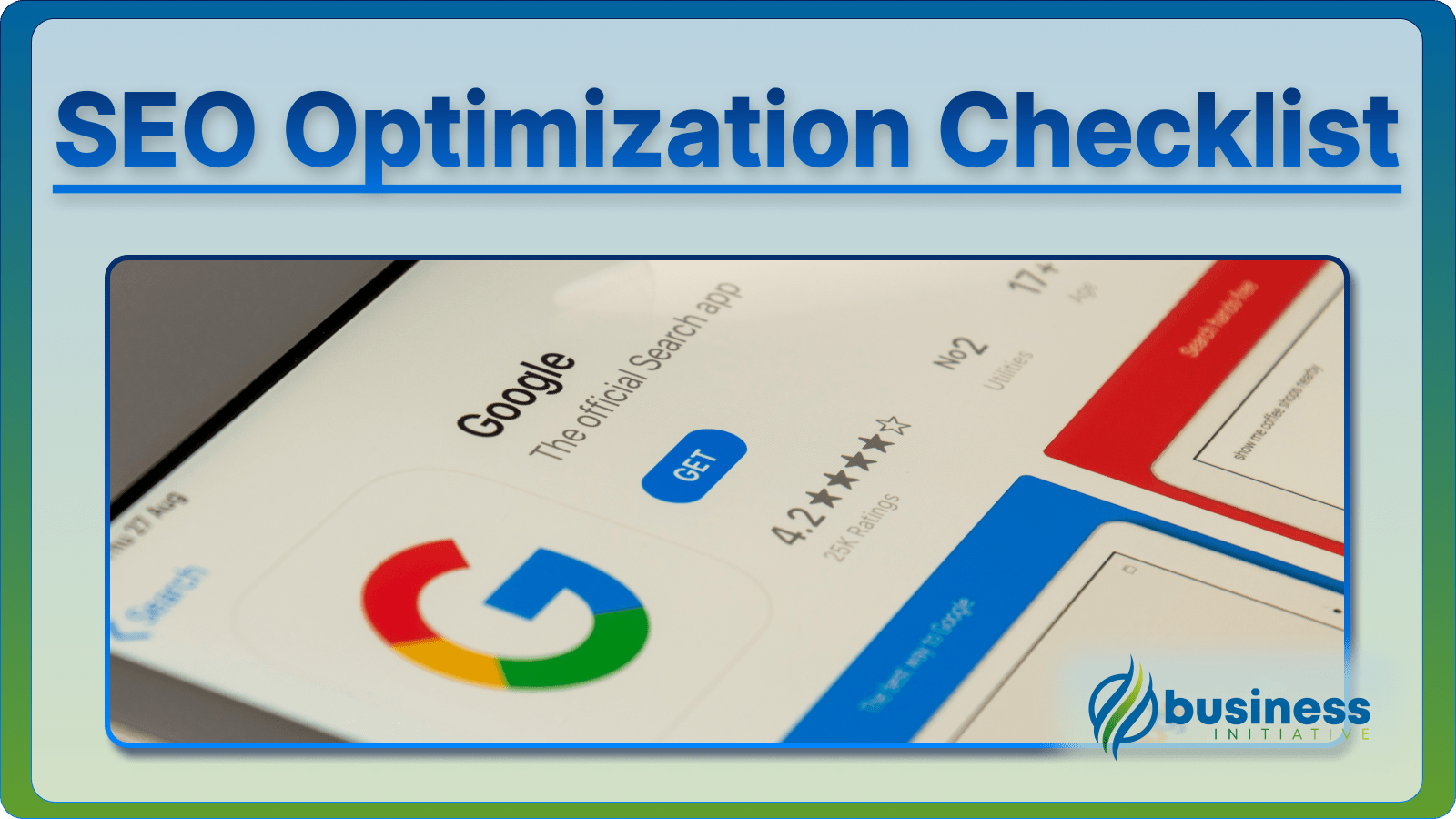Struggling to get your website noticed?
You’re not alone.
After analyzing hundreds of successful SEO campaigns and spending countless hours testing different strategies, I’ve distilled everything into this practical, no-nonsense guide.
This isn’t just another SEO article.
It’s a battle-tested roadmap based on real results and data.
I’ve personally used these exact strategies to help businesses rank higher and get more traffic.
What makes this guide different?
It’s all about action.
No fluff. No theory. Just nine concrete steps you can implement today.
 Key Takeaways
Key Takeaways
- Boost your website's authority and rankings by maintaining a clean backlink profile
- Attract more qualified leads and increase sales by targeting keywords with clear purchase intent
- Convert more visitors into customers with landing pages that match user search intent
- Keep visitors engaged and reduce bounce rates with fast-loading, mobile-friendly pages
- Stay ahead of competitors and maintain top rankings with regular content updates and local optimization
Each strategy comes from hands-on experience and proven results.
You’ll discover:
- How to clean up your backlink profile (even if you’re not technical)
- The exact tools to use for keyword research (all free)
- Simple ways to speed up your website
- How to outrank your competitors
- And much more
The best part?
You don’t need a big budget or technical skills.
Everything here is doable on your own.
Ready to transform your website’s performance?
Let’s dive into these nine essential steps that will take your SEO from average to outstanding.
1. Backlink Analysis and Cleanup
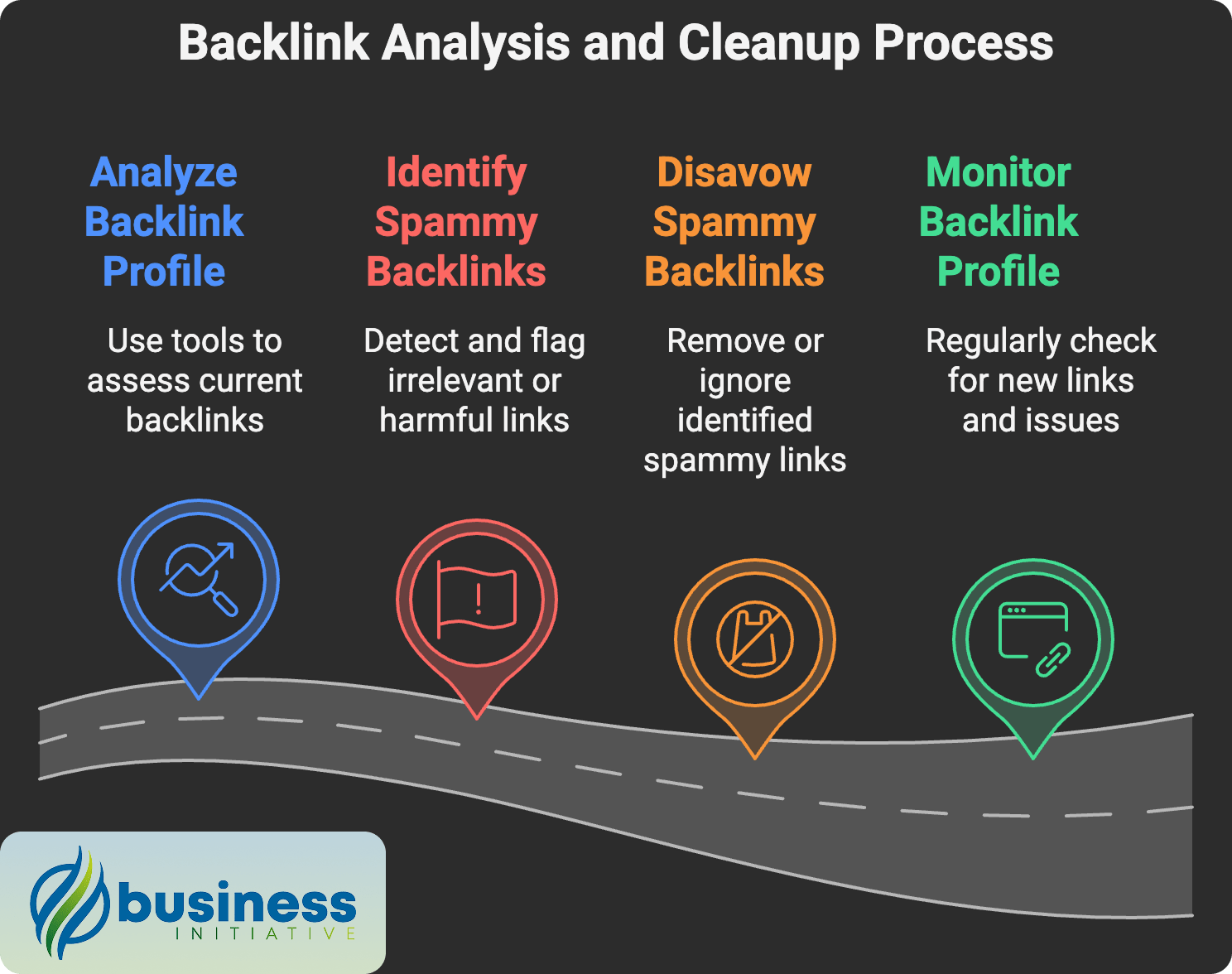
Why Does Checking Your Backlink Profile Matter?
Backlinks are the backbone of your website’s authority.
They serve as endorsements from other sites, signaling to search engines that your content is valuable and trustworthy.
A strong backlink profile can significantly boost your domain authority, which is a key factor in search engine rankings.
According to a study by Backlinko, pages with a high number of backlinks tend to rank higher on Google. Source.
What Are the Steps to Check Your Backlink Profile?
1. Analyze Your Backlink Profile:
Start by using free tools like Ahrefs Free Backlink Checker or Ubersuggest to get a comprehensive view of your current backlinks.
These tools provide insights into the number of backlinks, referring domains, and the overall health of your backlink profile.
2. Identify and Disavow Harmful Links:
Not all backlinks are beneficial.
Some can harm your SEO efforts, especially if they come from spammy or irrelevant sites. Use Google Search Console to identify these toxic links. Once identified, disavow them to prevent them from affecting your site’s reputation. This process helps maintain a clean and relevant backlink profile.
3. Regular Monitoring:
Backlink profiles are dynamic.
New links can appear, and existing ones can change.
Regularly monitor your backlink profile to catch any potential issues early.
Set up alerts in your chosen tool to notify you of significant changes.
This proactive approach ensures that your backlink strategy remains effective and aligned with your SEO goals.
By maintaining a clean and authoritative backlink profile, you enhance your site’s credibility and improve its chances of ranking higher in search results.
This ongoing process is crucial for long-term SEO success.
Calculate Your SEO ROI
Want to see the potential return on your SEO investment? Use our free SEO ROI calculator to project your growth and revenue potential.
2. Keyword Research with Intent
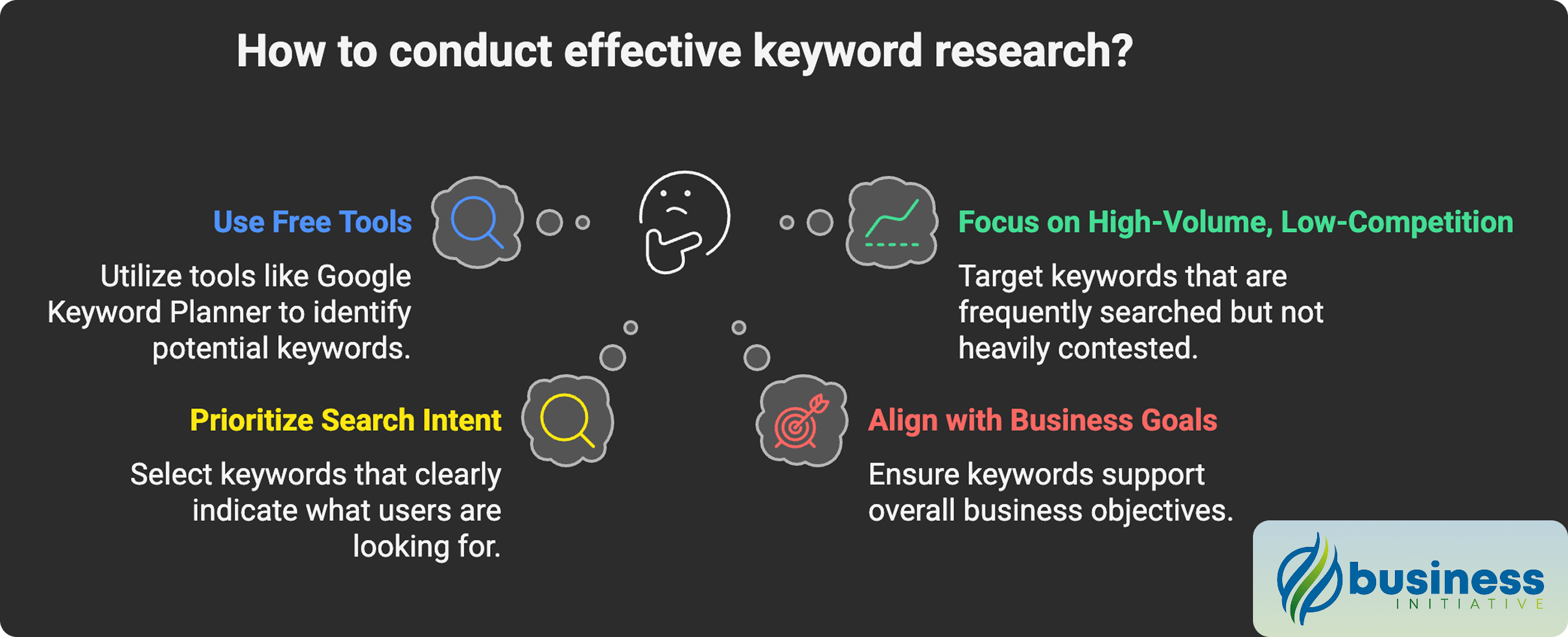
Why is Keyword Research Important?
Choosing the right keywords is crucial.
It boosts your website’s visibility on search engines.
This attracts visitors who are more likely to engage with your content and convert into customers.
According to a study by Ahrefs, 96.55% of pages get no organic search traffic from Google, primarily due to poor keyword targeting. (Source)
By focusing on keywords with clear intent, you ensure that your content meets the needs of your audience, leading to higher engagement and conversion rates.
How to Conduct Keyword Research?
1. Use Free Tools for Research:
Start with tools like Google Keyword Planner and AnswerThePublic.
These tools help you discover what your potential customers are searching for.
Google Keyword Planner provides insights into search volumes and competition levels, while AnswerThePublic visualizes search queries in a user-friendly format.
2. Identify High-Volume, Low-Competition Terms:
Look for keywords that have a high search volume but low competition.
This strategy increases your chances of ranking higher in search results.
For instance, a keyword like “best vegan protein powder” might have a high search volume but also high competition.
Instead, targeting a more specific term like “best vegan protein powder for athletes” could yield better results.
3. Focus on Search Intent:
Prioritize keywords that reflect the user’s intent.
This means understanding whether the searcher is looking to buy, learn, or compare.
For example, a keyword like “how to start an LLC in Florida” indicates a user looking for guidance on starting a business.
By aligning your content with this intent, you provide value and increase the likelihood of conversion.
4. Develop a Keyword Strategy Aligned with Business Goals:
Your keyword strategy should support your overall business objectives.
If your goal is to increase sales, focus on commercial intent keywords.
If you aim to build brand awareness, target informational keywords.
Regularly review and adjust your strategy based on performance metrics to ensure it remains effective.
By implementing these steps, you create a robust keyword strategy that enhances your SEO efforts and drives meaningful traffic to your site.
This approach not only improves your search engine rankings but also ensures that the traffic you attract is relevant and likely to convert.
3. Landing Page Optimization
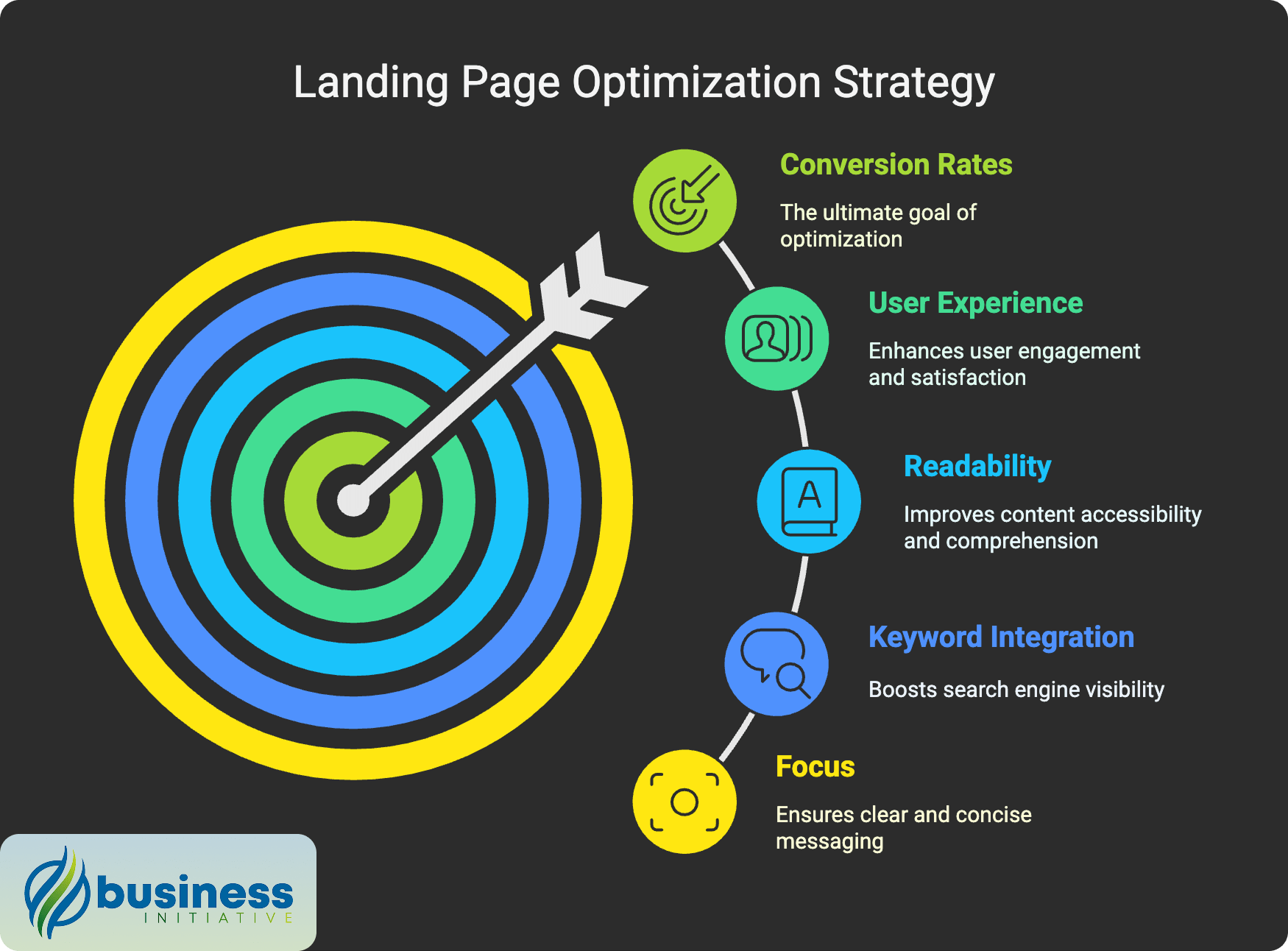
Why Does Landing Page Optimization Matter?
Landing page optimization is crucial for any website aiming to convert visitors into customers.
A well-optimized landing page significantly reduces bounce rates, which is the percentage of visitors who leave after viewing only one page.
According to a study by DataBox, the average bounce rate for websites is around 44.8% Source.
Lowering this rate means more users engage with your content, leading to improved user experience and higher conversion rates.
Conversion rates, the percentage of visitors who complete a desired action, are directly influenced by how well your landing page is optimized.
A report by Ruler Analytics indicates that the average conversion rate across industries is 2.9%Source.
By optimizing your landing pages, you can aim to be in that top tier.
What Are the Steps to Optimize Your Landing Pages?
1. Focus on One Primary Topic Per Page:
Each landing page should have a clear, singular focus.
This helps visitors immediately understand the purpose of the page and what action they should take.
Avoid clutter and distractions that can confuse or overwhelm users.
2. Incorporate Your Primary Keyword Strategically:
Use your primary keyword in key areas to improve search engine visibility.
Place it in the title tag, which is the first thing users see in search results.
Include it in the first paragraph to immediately signal relevance to both users and search engines.
Use it in headers (H1/H2) to structure your content logically.
Finally, ensure it appears in the meta description, which can influence click-through rates from search results.
3. Enhance Readability with Effective Techniques:
Make your content easy to read and digest.
Use short paragraphs to keep readers engaged.
Break up text with bullet points, which help highlight key information quickly.
Incorporate relevant visuals like images or infographics to support your message and make the page more visually appealing.
Finally, include clear calls-to-action (CTAs) that guide users toward the desired action, whether it’s signing up for a newsletter, making a purchase, or downloading a resource.
By following these steps, you create landing pages that not only attract visitors but also convert them into loyal customers.
This approach ensures your website performs at its best, driving business growth and success.
4. Site Speed Optimization

Why Does Site Speed Matter?
Site speed is crucial.
Google uses it as a ranking factor.
Faster sites rank higher.
They also provide a better user experience.
Users expect pages to load quickly.
According to Google, 53% of mobile users leave a site that takes longer than three seconds to load. (Source)
A fast site keeps users engaged.
It reduces bounce rates and increases conversions.
A study by Deloitte found that a 0.1-second improvement in mobile site speed can increase conversion rates by 8.4% for retail sites and 10.1% for travel sites.
What Are the Steps to Optimize Your Site Speed?
1. Analyze Load Time:
Use tools like PageSpeed Insights or GTmetrix.
These tools provide detailed reports on your site’s speed.
They highlight areas for improvement.
PageSpeed Insights offers suggestions based on real-world data.
GTmetrix provides a waterfall breakdown of your site’s loading process.
2. Implement Technical Improvements:
Start with compressing large images.
Use tools like TinyPNG to reduce image size without losing quality.
Enable lazy loading to defer offscreen images.
This technique improves initial load time.
Configure browser caching to store static files locally.
This reduces load times for returning visitors.
If your site remains slow, consider upgrading to a faster web host.
A reliable host can significantly improve site speed.
3. Monitor Performance Metrics Regularly:
Regular monitoring is essential.
Use Google Analytics to track site speed over time.
Set up alerts for significant changes.
This proactive approach helps maintain optimal performance.
It ensures your site remains fast and user-friendly.
By optimizing site speed, you enhance user satisfaction and improve your search engine rankings.
This ongoing process is vital for maintaining a competitive edge in the digital landscape.
5. Schema Markup Implementation
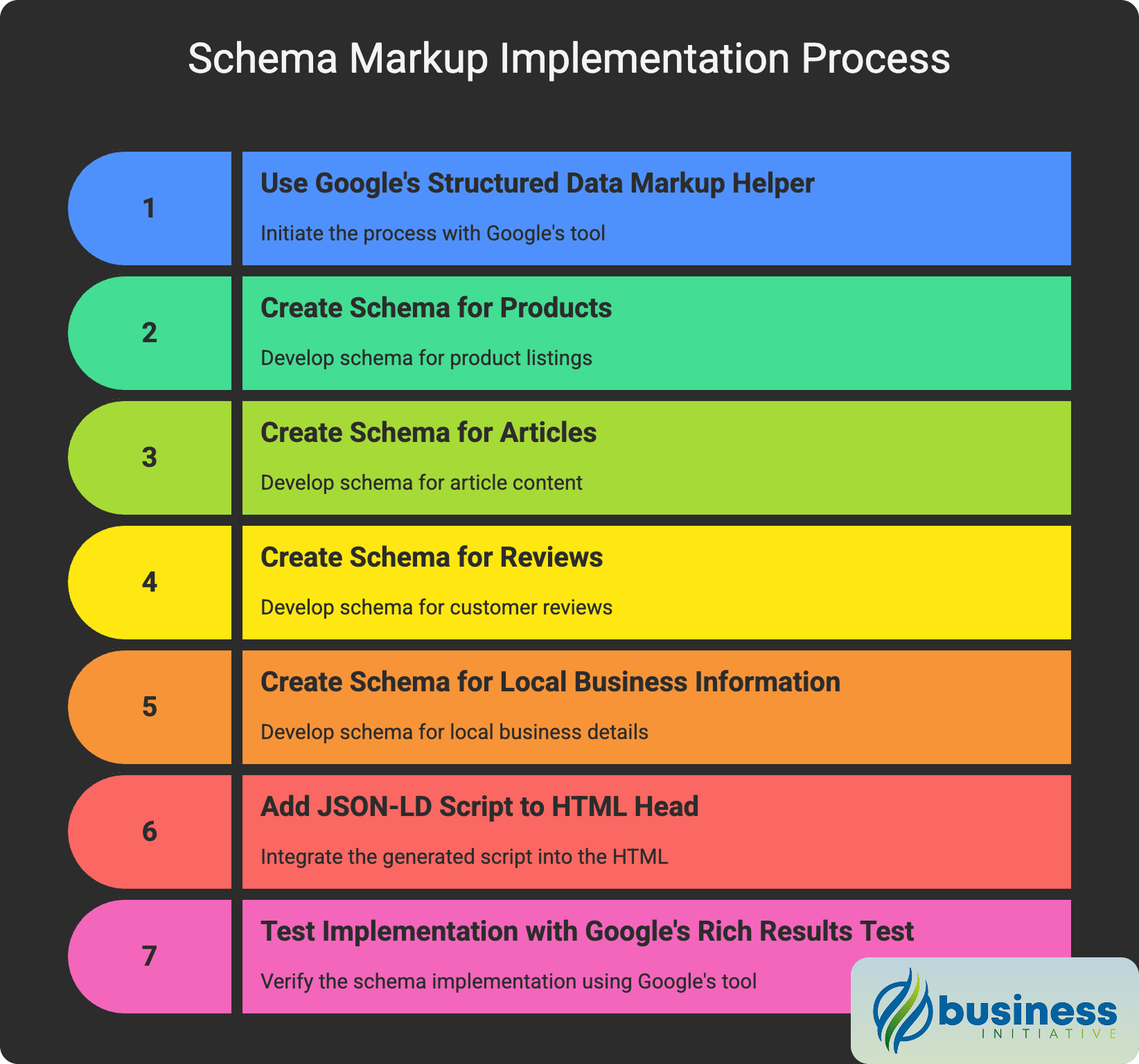
Why Does Schema Markup Matter?
Schema markup is a powerful tool that enhances how search engines interpret your website’s content.
By providing structured data, you help search engines like Google understand the context and details of your pages.
This understanding can lead to the display of rich snippets in search results, which are visually appealing and informative.
Rich snippets can include star ratings, product prices, or event details, making your listing stand out.
This increased visibility can drive more traffic to your site.
According to a study by Search Engine Land, websites with rich snippets can see a 30% increase in click-through rates. (Source)
What Are the Steps to Implement Schema Markup?
1. Utilize Google’s Structured Data Markup Helper:
This tool simplifies the process of adding schema markup to your site.
It guides you through tagging your content, making it accessible even for those with limited technical expertise.
You can access it here.
2. Create Schema for Key Elements:
Focus on essential elements that can benefit from structured data.
For products, include details like price, availability, and reviews.
For articles, highlight the headline, author, and publication date.
Reviews should feature the reviewer and rating.
Local business information should cover the name, address, and opening hours.
This comprehensive approach ensures that all relevant data is structured for optimal search engine understanding.
3. Add the Generated JSON-LD Script to Your HTML Head:
Once you’ve created your schema markup, integrate it into your website.
JSON-LD is the recommended format by Google for adding structured data.
Place the script in the head section of your HTML to ensure it is recognized by search engines.
4. Test Implementation Using Google’s Rich Results Test:
After adding schema markup, verify its effectiveness using Google’s Rich Results Test.
This tool checks if your page supports rich results and identifies any errors in your structured data.
Regular testing ensures your markup remains effective and up-to-date.
Access the tool here.
By implementing schema markup, you enhance your site’s search engine visibility and user engagement.
This strategic move not only improves your SEO but also provides a better user experience by delivering more relevant and detailed information directly in search results.
6. Competitor Analysis
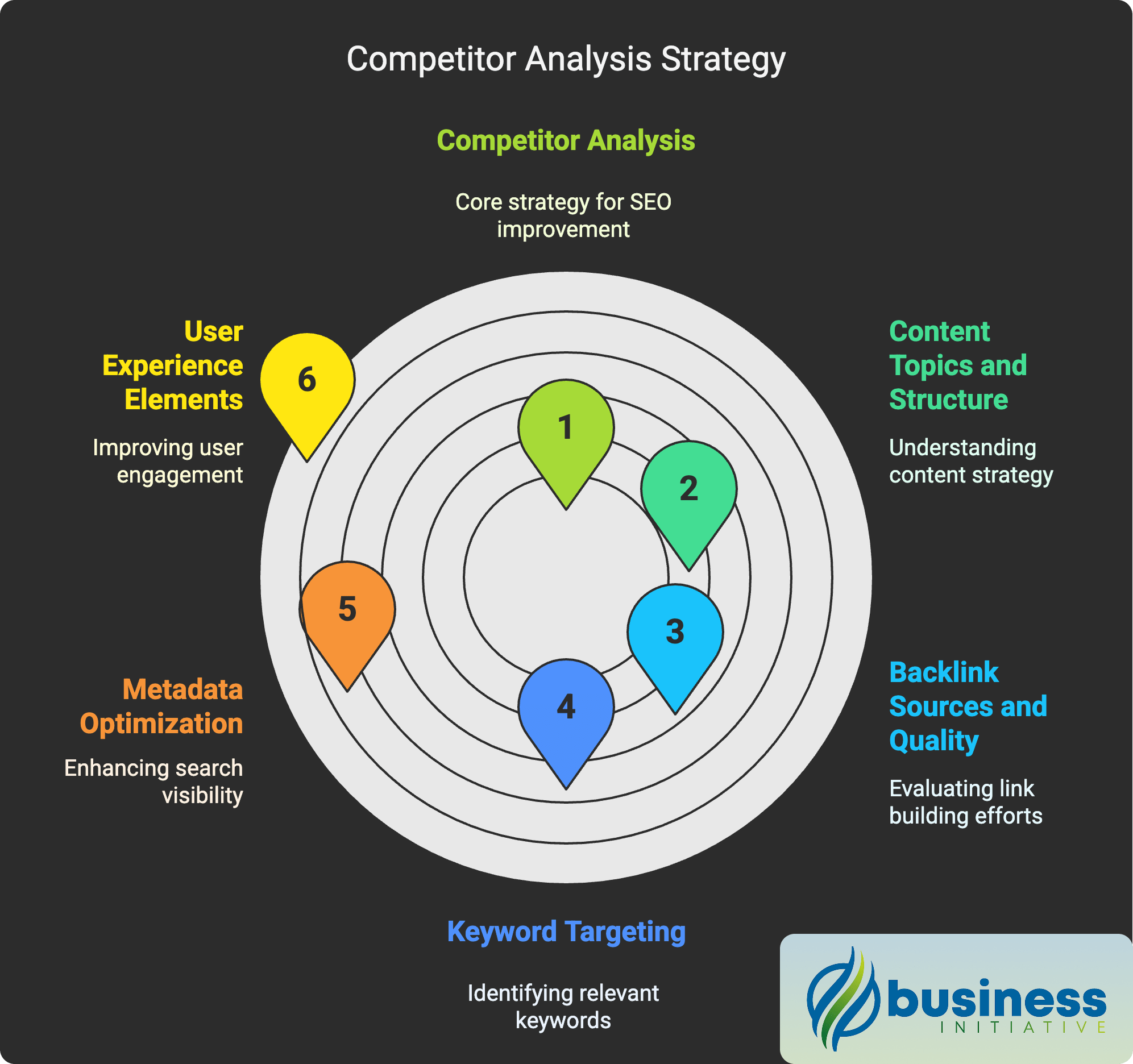
Why Does Competitor Analysis Matter?
Competitor analysis is a crucial part of your SEO strategy.
It allows you to understand what your competitors are doing right and where they fall short.
By analyzing their strategies, you can uncover opportunities to improve your own SEO efforts and gain a competitive edge.
This process helps you identify the strengths and weaknesses in your competitors’ approaches, enabling you to refine your tactics and outperform them in search results.
According to a study by SEMrush, 91% of marketers believe that competitor analysis is essential for success in digital marketing.
What Are the Steps to Conduct Competitor Analysis?
1. Leverage Powerful Tools:
Use tools like SimilarWeb to gain insights into your competitors’ traffic sources, audience demographics, and engagement metrics.
These tools provide a comprehensive overview of your competitors’ online presence.
Alternatively, conduct a manual analysis by visiting their websites and observing their content and design.
2. Examine Content Topics and Structure:
Analyze the topics your competitors cover and how they structure their content.
Look for patterns in their blog posts, articles, and landing pages.
Identify which topics generate the most engagement and consider how you can offer more value or a unique perspective.
3. Analyze Backlink Sources and Quality:
Backlinks are a significant ranking factor in SEO.
Use tools like Ahrefs or Moz to examine your competitors’ backlink profiles.
Identify high-quality sources linking to their sites and explore opportunities to earn similar backlinks for your own site.
4. Evaluate Keyword Targeting:
Investigate the keywords your competitors are targeting.
Use tools like SEMrush or Ubersuggest to discover their top-performing keywords.
Determine if there are untapped keyword opportunities that align with your business goals.
5. Assess Metadata Optimization:
Review your competitors’ metadata, including title tags and meta descriptions.
Ensure your metadata is optimized to be more compelling and relevant to search queries.
This can improve your click-through rates and search visibility.
6. Consider User Experience Elements:
User experience (UX) plays a vital role in SEO.
Analyze your competitors’ website design, navigation, and mobile responsiveness.
Identify areas where you can enhance your site’s UX to provide a better experience for your visitors.
7. Identify Gaps and Opportunities:
After gathering insights, identify gaps in your competitors’ strategies.
Look for areas where they may be lacking or where you can offer something unique.
Use this information to refine your own SEO strategy and capitalize on opportunities to stand out in the market.
By conducting a thorough competitor analysis, you gain valuable insights that can inform your SEO strategy and help you achieve better search rankings.
This proactive approach ensures you stay ahead of the competition and continuously improve your online presence.
7. SEO Goal Setting and Tracking
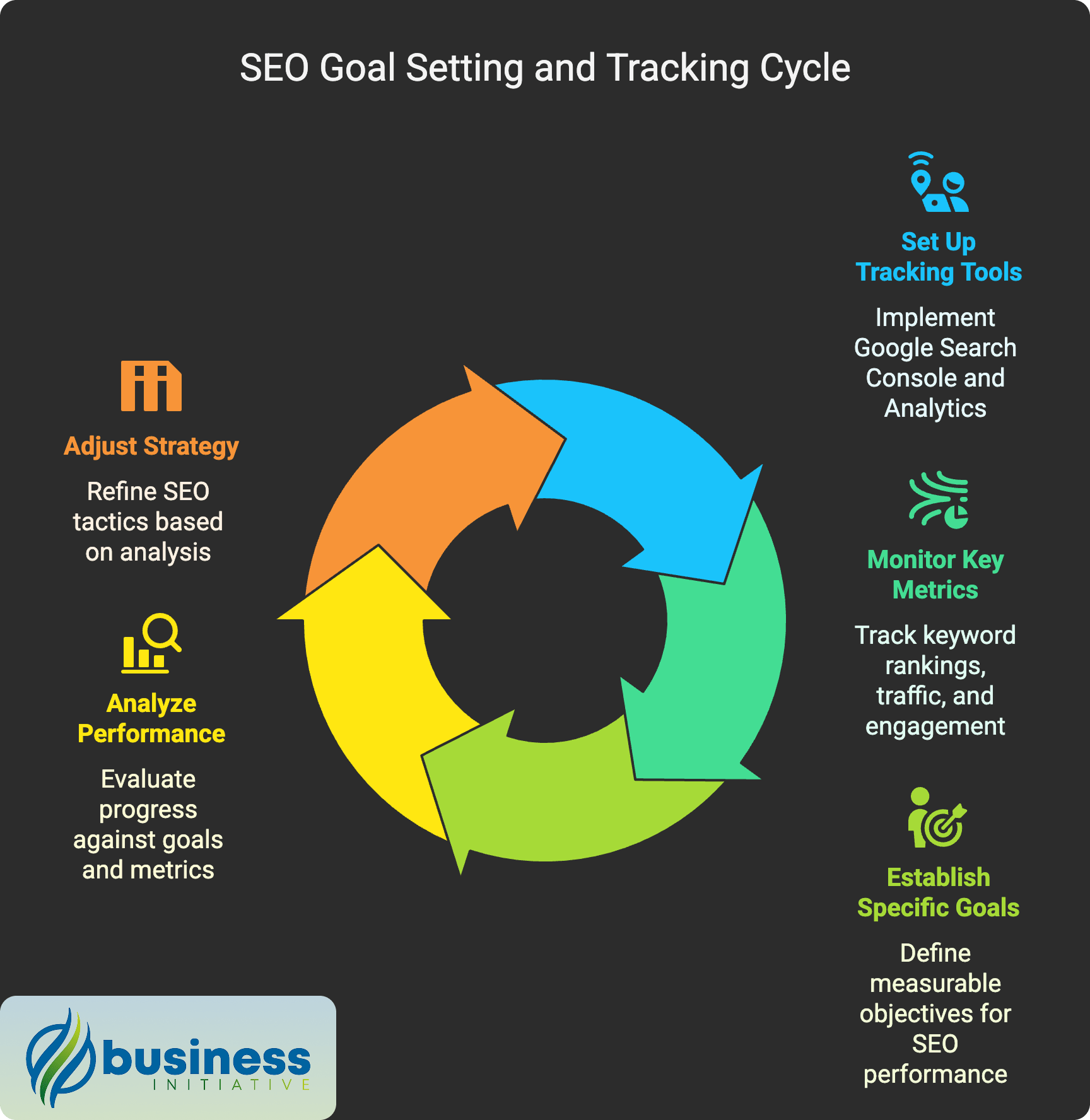
Why is SEO Goal Setting and Tracking Important?
SEO is not a sprint.
It’s a marathon.
You need clear goals and consistent monitoring to measure success.
Without these, your efforts may lack direction and focus.
Setting specific objectives helps you stay on track and evaluate progress.
It ensures that your SEO strategy aligns with your business goals.
According to a study by HubSpot, companies that set specific goals are 10 times more likely to achieve them. (Source)
What Are the Steps to Set and Track SEO Goals?
1. Set Up Tracking Systems:
Begin by implementing robust tracking systems.
Use Google Search Console to monitor your site’s presence in Google search results.
It provides insights into how Google views your site and helps you optimize its performance.
Pair this with Google Analytics to gain a deeper understanding of your audience’s behavior.
This tool tracks user interactions, providing data on how visitors engage with your site.
2. Monitor Key Metrics:
Regularly check key performance indicators to gauge your SEO success.
Focus on keyword rankings to see how well your site performs for targeted search terms.
Track organic traffic to measure the number of visitors coming from search engines.
Analyze click-through rates to understand how often users click on your links in search results.
Keep an eye on bounce rates to identify pages that may need improvement.
These metrics offer a comprehensive view of your site’s performance.
3. Establish Specific, Measurable Goals:
Define clear, achievable objectives to guide your SEO efforts.
For example, aim to “Rank on page 1 for X keyword in 3 months.”
This goal provides a specific target and timeframe, making it easier to track progress.
Another goal could be to “Increase organic traffic by 25%.”
This objective focuses on boosting the number of visitors from search engines, which can lead to higher conversions and revenue.
Setting measurable goals ensures you can evaluate the effectiveness of your SEO strategy and make necessary adjustments.
By setting clear goals and tracking your progress, you create a roadmap for SEO success.
This approach helps you stay focused, make informed decisions, and achieve better results in search engine rankings.
Remember, SEO is an ongoing process that requires dedication and adaptability.
Keep refining your strategy to stay ahead in the ever-evolving digital landscape.
8. Content Strategy Development
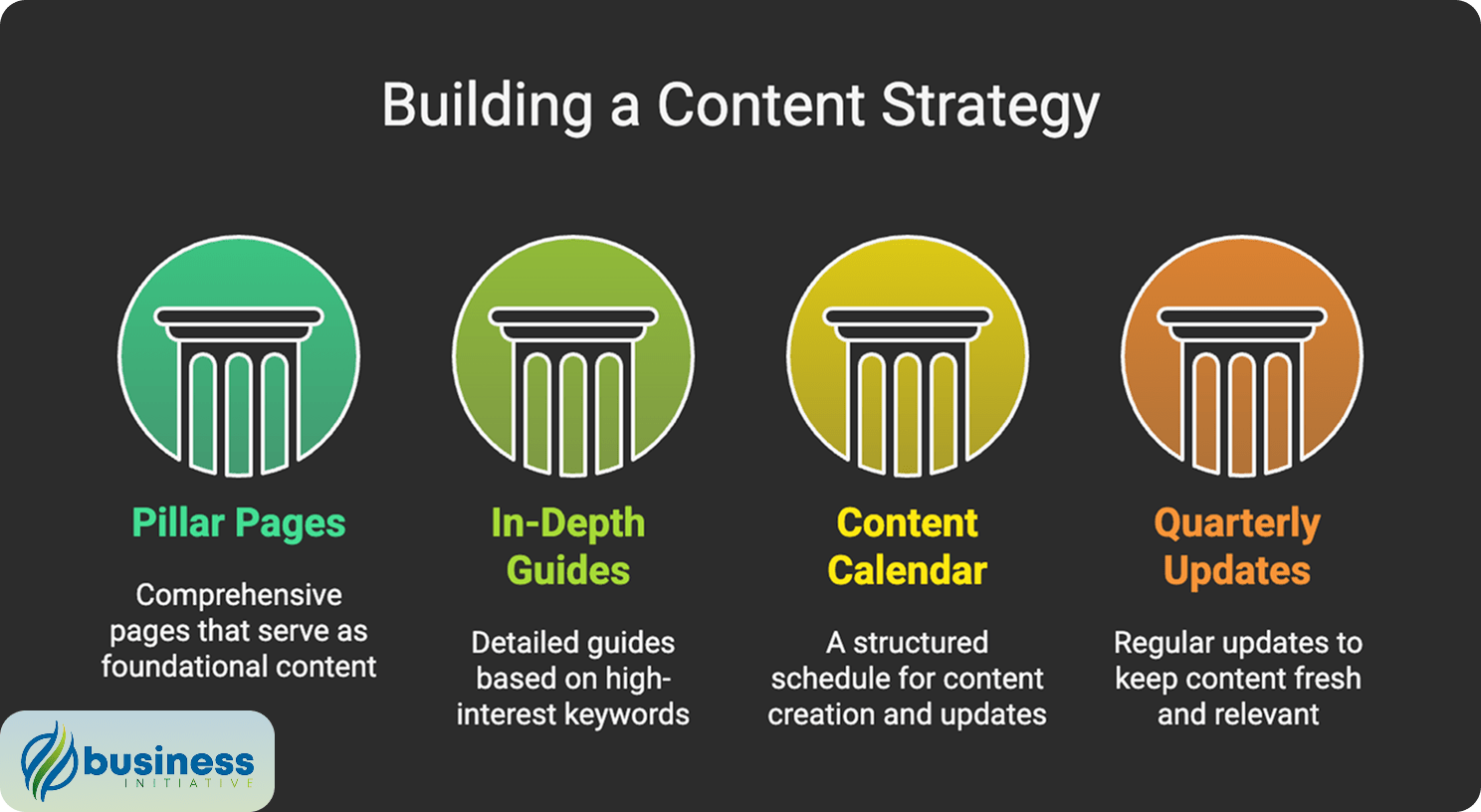
Why is Content Strategy Development Necessary?
Creating high-value, evergreen content is crucial for establishing your website’s authority.
It attracts backlinks from other reputable sites, which boosts your site’s credibility and search engine rankings.
Evergreen content remains relevant over time, ensuring that your site maintains its position in search results long after publication.
According to a study by HubSpot, companies that blog regularly receive 97% more links to their websites. (Source)
What Are the Steps to Develop a Content Strategy?
1. Create Comprehensive Pillar Pages:
Develop pillar pages that cover broad topics in depth.
These pages serve as the cornerstone of your content strategy.
They provide a detailed overview of a subject and link to related content on your site.
This structure helps search engines understand the relationship between your content pieces, improving your site’s SEO.
2. Develop In-Depth Guides Based on High-Interest Keywords:
Identify keywords that your target audience frequently searches for.
Use tools like Google Keyword Planner or Ahrefs to find these keywords.
Create detailed guides that address these topics thoroughly.
This approach not only attracts more visitors but also positions your site as an authority in your industry.
3. Implement a Content Calendar:
Plan your content creation and publication schedule using a content calendar.
This tool helps you organize your ideas, set deadlines, and ensure a consistent flow of content.
Consistency is key to maintaining audience engagement and improving your site’s SEO.
4. Update Content Quarterly:
Regularly refresh your content to keep it relevant and accurate.
Every quarter, review your existing content and update it with new statistics, internal links, and content improvements.
Ensure that all information is current.
This practice not only enhances the user experience but also signals to search engines that your site is active and up-to-date.
By following these steps, you can develop a robust content strategy that enhances your site’s authority and search engine performance.
Remember, content strategy is an ongoing process that requires regular attention and adaptation to changing trends and audience needs.
Stay proactive and keep refining your approach to achieve long-term success.
9. Local SEO Optimization
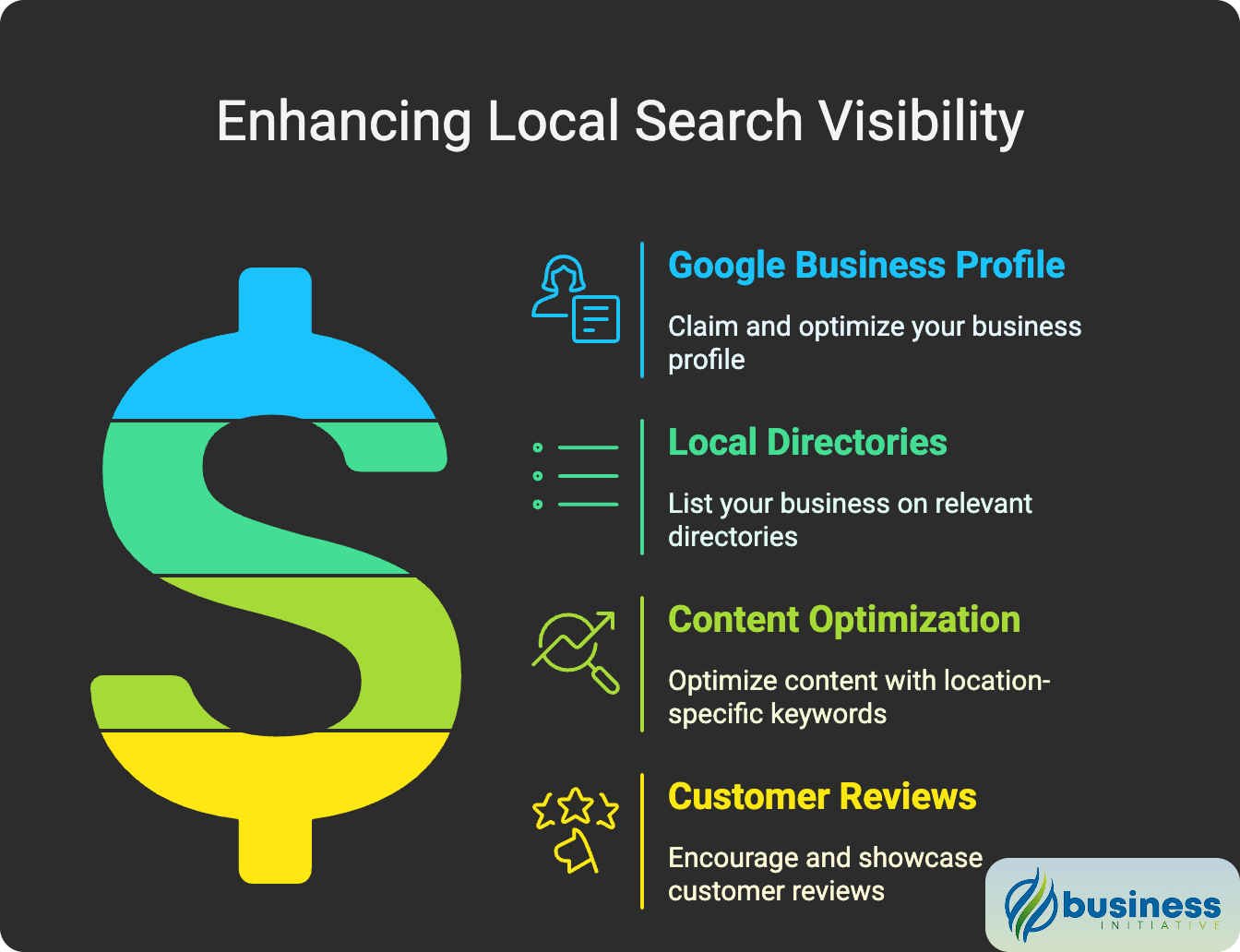
Why is Local SEO Optimization Important?
Local SEO is essential for service-based or physical businesses.
It helps attract customers in your area.
When people search for services nearby, they often choose businesses that appear in local search results.
According to Google, 46% of all searches have local intent.
This means nearly half of the people searching online are looking for local information.
If your business isn’t optimized for local search, you miss out on potential customers.
Local SEO ensures your business appears in these searches, increasing your visibility and attracting more customers.
What Are the Steps to Optimize Your Local SEO?
1. Claim and Optimize Your Google Business Profile:
Start by claiming your Google Business Profile.
This is a free tool that lets you manage how your business appears on Google Search and Maps.
Ensure your profile is complete and accurate.
Include your business name, address, phone number, and hours of operation.
Add photos to showcase your business.
Encourage customers to leave reviews.
Respond to reviews to show you value customer feedback.
A well-optimized profile can significantly boost your local search visibility.
2. Get Listed on Relevant Local Directories:
Increase your online presence by listing your business on local directories.
Start with popular platforms like Yelp, Better Business Bureau, and your local chamber of commerce.
These directories help improve your local SEO by providing backlinks to your site.
They also make it easier for potential customers to find you.
Consider industry-specific directories relevant to your business.
Consistency is key.
Ensure your business information is the same across all platforms.
3. Optimize Content with Local Keywords:
Use city and keyword combinations in your content.
This helps search engines understand your location and services.
For example, if you run a bakery in Austin, use phrases like “Austin bakery” in your titles and content.
Create location-specific URLs to target local customers.
Implement local business schema markup on your website.
This code helps search engines display your business information in search results.
Encourage customer reviews and testimonials.
Positive reviews build trust and improve your local search ranking.
By focusing on local SEO, you enhance your business’s visibility in local search results.
This strategy attracts more nearby customers and drives growth.
Stay proactive and keep optimizing your local SEO efforts to maintain a competitive edge in your area.
FAQs - Frequently Asked Questions About SEO Optimization for Small Businesses

How long does it take to see results from SEO efforts?
SEO typically takes 3-6 months to show significant results, but the exact timeline varies based on your starting point and competition.
Learn More...
SEO is a long-term investment that requires patience and consistent effort.
The timeline for seeing results depends on several factors:
- Your website's current authority and age
- The competitiveness of your industry
- The quality and frequency of your content updates
- Your technical SEO implementation
- The strength of your backlink profile
According to the article's research, companies that set specific SEO goals are 10 times more likely to achieve them.
To track progress effectively, monitor key metrics like:
- Keyword rankings
- Organic traffic growth
- Click-through rates
- Bounce rates
- Conversion rates
Focus on creating high-quality, evergreen content that remains relevant over time.
Companies that blog regularly receive 97% more links to their websites, accelerating SEO progress.
Why is my website loading slowly and how can I fix it?
Slow loading times are often caused by large images, poor hosting, and unoptimized code.
Fix it by compressing images, enabling caching, and considering a better hosting provider.
Learn More...
Website speed is crucial for both user experience and SEO rankings.
According to Google, 53% of mobile users abandon sites that take longer than three seconds to load.
A Deloitte study found that improving mobile site speed by just 0.1 seconds can:
- Increase retail conversion rates by 8.4%
- Increase travel site conversion rates by 10.1%
To improve your site speed:
- Use tools like PageSpeed Insights or GTmetrix to analyze current performance
- Compress large images using tools like TinyPNG
- Enable lazy loading for images
- Configure browser caching
- Upgrade to a faster web host if necessary
Monitor your site's performance regularly using Google Analytics to ensure improvements are maintained.
How important is local SEO for my business?
Local SEO is crucial as 46% of all Google searches have local intent.
Learn More...
Local SEO can significantly impact your business's visibility and customer acquisition.
Here's why local SEO matters:
- Nearly half of all searches are looking for local information
- Local searches often have higher conversion rates
- Mobile searches often lead to same-day store visits
To optimize for local SEO:
- Claim and fully optimize your Google Business Profile
- Get listed on key directories like Yelp and BBB
- Maintain consistent NAP (Name, Address, Phone) across all platforms
- Implement local business schema markup
- Create location-specific content and URLs
Focus on generating and responding to customer reviews, as they significantly impact local search rankings.
Use city + keyword combinations in your content to target local searches effectively.
What role do backlinks play in SEO?
Backlinks act as votes of confidence from other websites, directly affecting your domain authority and search rankings.
Learn More...
Backlinks remain one of the most important ranking factors in Google's algorithm.
According to Backlinko's study, pages with more backlinks tend to rank higher in search results.
To build a strong backlink profile:
- Use tools like Ahrefs or Ubersuggest to analyze current backlinks
- Identify and disavow toxic or spammy links
- Create high-quality, linkable content
- Monitor competitors' backlink sources
- Regularly check for new backlinks
Focus on quality over quantity - one high-authority backlink can be worth more than many low-quality ones.
Implement a content strategy that naturally attracts backlinks through:
- Comprehensive pillar pages
- In-depth industry guides
- Original research and statistics
- Infographics and visual content
Regular monitoring and cleanup of your backlink profile is essential for maintaining strong SEO performance.
In Summary…
This comprehensive SEO guide provides you with nine battle-tested strategies to improve your website’s search engine performance.
From technical optimizations to content strategy, we’ve outlined actionable steps that can transform your online presence.
The Real-World Impact
When implemented correctly, these SEO strategies can deliver significant results:
- Increased organic traffic through better search rankings
- Higher conversion rates from qualified visitors
- Improved local visibility for your business
- Stronger domain authority through quality backlinks
- Better user experience leading to longer site visits
- Enhanced mobile performance and faster loading times
Your Path to Success
Remember, SEO isn’t about quick fixes.
It’s about building a strong foundation for long-term success.
The strategies outlined in this guide have helped businesses achieve remarkable results:
- 53% reduction in bounce rates through speed optimization
- Up to 30% increase in click-through rates with rich snippets
- 8.4% boost in conversion rates through mobile optimization
- 97% more backlinks through consistent content creation
Taking Action
The best time to improve your SEO is now.
Here’s how to get started:
1. Assess Your Current Position - Review your website’s current performance - Identify quick wins and long-term opportunities - Set clear, measurable goals
2. Create Your Implementation Plan - Prioritize the strategies that will have the biggest impact - Develop a realistic timeline - Allocate resources effectively
3. Monitor and Adjust - Track your progress using the metrics we’ve discussed - Make data-driven decisions - Continuously optimize your approach
Calculate Your SEO ROI
Want to see the potential return on your SEO investment? Use our free SEO ROI calculator to project your growth and revenue potential.
Ready to Transform Your Online Presence?
Don’t let your website underperform in search results.
Take the Initiative and start improving your SEO performance today…
🤝 Get Personalized Guidance
Schedule a free consultation with our SEO experts at Business Initiative.
We’ll analyze your current SEO performance and create a customized strategy for your business.
Schedule Your Free SEO Consultation →
📝 Have Questions?
Our team is here to help.
Reach out through our contact form, and we’ll get back to you within 48 hours.
Remember: Every day your website isn’t optimized is a missed opportunity to connect with potential customers. Take action now to secure your place at the top of search results.
📫 Stay Updated
Don’t miss our latest SEO tips and strategies:
Sources & Additional Information
Here are all of the sources used to write this article:
- Backlinko's SEO Research: A comprehensive study on the impact of backlinks on search rankings.
- Google's Mobile Site Speed Playbook: Insights into the importance of site speed and its effect on user experience and SEO.
- Search Engine Journal's Local SEO Guide: A detailed guide on optimizing for local search to enhance business visibility.
- Matt Giaro's Blogging Insights: An article discussing the profitability and SEO benefits of consistent blogging.
- HubSpot's Goal Setting Research: A study on the importance of setting specific goals in SEO.
- Search Engine Land's Rich Snippets Increase CTR: A study on the impact of rich snippets on click-through rates.
- SEMrush's Competitor Analysis: A guide on analyzing your competitors' SEO strategies.
- Google's Structured Data Markup Helper: A tool for adding schema markup to your website.
- Google's Rich Results Test: A tool for testing your page's rich results.
- Search Engine Journal's Local SEO Guide: A detailed guide on optimizing for local search to enhance business visibility.
Here are some additional resources that can be useful for learning more about SEO:
- Moz's Beginner's Guide to SEO: A foundational resource for understanding the basics of SEO and how to implement effective strategies.
- Ahrefs Blog: Offers a wealth of articles and tutorials on advanced SEO techniques and tools.
- Neil Patel's SEO Blog: Provides actionable SEO tips and strategies from one of the industry's leading experts.
These resources will help you stay informed about the latest trends and best practices in SEO, empowering you to optimize your website effectively.


